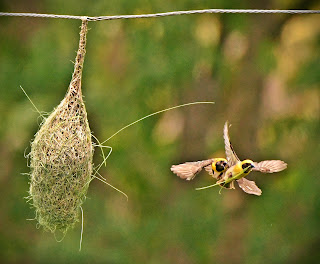The Winged Whisperers
Winged Whisperer:
(Part 3 - The Growth)
(Part 3 - The Growth)
A
large part of my fascination with forests has centred around the big cats,
especially the tiger. With subsequent visits to forests I developed a fondness
for leopards, one of the most agile and resilient cats, and the Himalayan Black
Bear – a royal and elegant species. Unknown to the wider world, tiger stripes
are like fingerprints and no two stripes are same. Same is the case of spots on
a leopard. Every leopard has different spots called rosettes, and a black panther
is nothing but a regular melanistic leopard whose dark or black coloration
hides the spots. The stripes and rosettes on cats’ act as a camouflage and
serve a dual purpose, as a defence mechanism and / or as a stalking tool. In my
jungle safaris, I met fellow wild-lifers who were fascinated by different
species, like birds, macro animals, etc. though I had been content being a cat
person. I occasionally clicked birds, but only in action, and only while
waiting for a cat to appear, as cat sighting is a patient affair.
 And
then one day an animated birder introduced me to the truly amazing world of
birds. He was surprised that I was not interested in birds and went on to
explain bird habits of a baya weaver, a smallish 3-inch yellow bird. The male
baya weaver builds 5-6 nests at a time to attract a female, the female comes to
inspect them and then if she accepts to co-habit, she will stay in one of the nests.
However, life is never easy. In this picture that I took in mid-2017 I
witnessed how a competitor tried to steal the best piece of straw, before the
arrival of the female, so that the male’s efforts were not successful.
And
then one day an animated birder introduced me to the truly amazing world of
birds. He was surprised that I was not interested in birds and went on to
explain bird habits of a baya weaver, a smallish 3-inch yellow bird. The male
baya weaver builds 5-6 nests at a time to attract a female, the female comes to
inspect them and then if she accepts to co-habit, she will stay in one of the nests.
However, life is never easy. In this picture that I took in mid-2017 I
witnessed how a competitor tried to steal the best piece of straw, before the
arrival of the female, so that the male’s efforts were not successful.
This introduction to birding opened up a completely new vista and I joined a birders group in Delhi in the beginning of 2018. With them I explored some amazing birding spots around Delhi, and developed beautiful meaningful friendships for life with fellow birders.
The sarus dance was followed by an egret
courtship ritual, on a foggy winter morning, and it further left me spellbound.
It felt as if there was music in the air
that the birds could hear and that I was blessed to be a witness to the amazing
moment.
Post
the introduction to this heavenly magic, I travelled to Kaziranga in Eastern
India, to the land of great hornbills, and to Chiplun a coastal town in Western
India, in search of the Oriental Dwarf King Fisher (ODKF), a migratory visitor
to our coastal areas.
Monsoon
heralds the arrival of ODKF, one of the tiniest and most colourful bird of the
coastal areas. This bird too births and nurtures
its new born with an unimaginable dedication.
Since
then I have been blessed to see birds in all shapes and sizes, having beautiful
patterns and colours (just the Indian Pita has 9 colours!) without one dot or
line being out of place, and even a tiny bird like the red munia becomes bright
red during breeding season and duller in non-breeding season. Then there are
migratory birds that come to India during winters, escaping harsher climates in
their own region, and are a delight to birdwatchers in India. The birds prefer unique
habitats, some having preference for marshes, yet other to wetlands and quite a
few water birds. And each of these birds display unique behaviours of mating,
breeding, killing / safeguarding depending on whether they are prey or
predator, every parent being protective of their offspring. All of this has added
to the awe factor that I already had for wildlife and biodiversity. Every
sighting has seemed like unfolding of a new mystery and grace that surrounds
us.
It is
while watching birds that I also started noticing communities in which these birds
bred and the community involvement and buy-in that is most essential to conservation.
I have seen villages that are proud of their heritage of sarus cranes (Delhi
NCR) and pelicans (Mysore), even though these birds may destroy crops or dirty
the place; a village in Gujarat that went from being scared of crocodiles, and
considering it to be a danger, to living amicably with them. These efforts inspired
awe and a desire to participate, to contribute, to get involved in
conservation.
I am
new to this field of conservation, I do not have the technical expertise
required for dialogue and / or design intervention, but that is compensated by
the selfless burning drive to spearhead a change. And as Paulo Coelho says, “When
you want something, all the universe conspires in helping you achieve it.”






Informative 👍👌
ReplyDeleteLovely article.. Congratulations.. Regards Rajasekar IFS
ReplyDelete